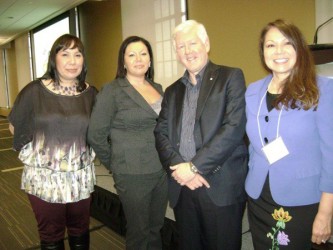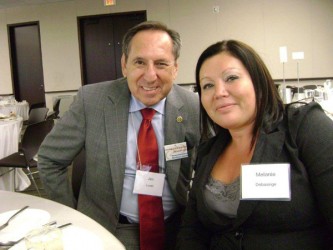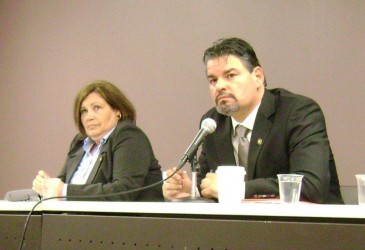Article Origin
Volume
Issue
Year
For the first time since its inception five years ago, the Toronto International Microfinance Summit, held in Toronto on Oct. 5, shone a light on First Nations and Aboriginal peoples.
Summit Vice-President and Co-Chair Jim Louttit thinks it’s about time.
He’s also the Chair and President of the Rotarian Action Group for Microfinance and Community Development and has seen the benefits of microfinance first-hand in the developing world.
Microfinance is a poverty-reduction tool that includes access to microcredit, savings accounts and insurance and had its start in Bangladesh.
Louttit said he’s heard about microfinance projects, and people always want to go to Africa or India.
“My thought is, let’s not forget where we live,” said Louttit. First Nations in Canada have some of the same poverty issues and lack of access to credit and banking services as in other countries, and examining the applicability of microfinance to First Nations communities makes sense.
Keynote speaker Bob Rae echoed Louttit’s sentiments. Rae, former Liberal MP for the Toronto Centre riding, is now the advisor to the Matawa Tribal Council in northern Ontario on the Ring of Fire development.
“We are a country with a deep colonial experience,” said Rae, adding it is no different from hundreds of other countries around the world where poverty and underdevelopment amongst the original people was a consequence of colonization.
If anyone wants to see conditions of real underdevelopment and its impact on people, you don’t have to go very far, Rae said.
“It’s critically important as Canadians that we understand and that we totally embrace the simple reality that this is our world too,” Rae said.
In order to tackle the issue of underdevelopment and its ensuing poverty amongst First Nations and other Aboriginal people in this country, Rae stressed the importance of capacity-building but as a two-way street.
Yes, the capacity of First Nations communities has to be developed, he said, but “we need to build capacity in the broader Canadian community to understand the reality of the lives” of First Nations people living in northern communities.
“The capacity-building has to happen at the centres of power and at the centres of influence and at the centres of profitability,” he said.
Betty Ann Lavallee, national chief of the Congress of Aboriginal People, was featured on a panel with Isadore Day, chief of Serpent River First Nation in northern Ontario. Lavallee said bold and innovative initiatives are needed to address the long-standing inequity experienced by off-reserve Aboriginal people. It’s essential this be done in collaboration with Aboriginal organizations and communities, the federal government and provincial and territorial governments, she said. For starters, an “open and honest dialogue with respect to Aboriginal-specific policies and programs and issues facing off-reserve Aboriginal peoples is needed,” Lavallee said.
“A national microfinance program that has the support of the private sector and all levels of government could be a game-changer,” said Lavallee. She said there is evidence to show that community-based economic development programs do work, but the success comes from looking at the whole individual and not just their financial position.
After giving a quick lesson on Canadian history and colonization, Chief Day said Serpent River First Nation will be developing a microfinance strategy that is a “people-propelled process.” He expects a plan to be formalized in 2014-15 with implementation to follow.
The context within which First Nations people have to survive includes the social issues resulting from colonization and provides a challenge, he said, but, “it’s up to us to actually find ways to move our people forward in a formal microfinance perspective.”
Dawn Madahbee is the general manager of Waubetek Business Development Corporation, which is part of a network of about 50 such organizations in the country. Waubetek is an Aboriginal-owned and controlled organization that delivers business financing and economic development services to First Nations and Aboriginal entrepreneurs in Northeastern Ontario, an area that includes 27 First Nations. Madahbee has been with the organization since its inception 25 years ago.
In an interview following the Microfinance Summit, Madahbee said Waubetek has invested $55 million in Aboriginal people and has served more than 2,000 entrepreneurs. Strictly speaking, they’re not involved in microfinance, although she said they provide business development services and support as well as business loans. Loans range from $500 to $250,000, with the average loan size being about $30,000. Madahbee says 94 per cent of their clients stay in business, a rate higher than the Canadian average. Their loan loss rate is only around three per cent.
“There’s definitely a need for microfinance,” said Madahbee because the Aboriginal income in Canada is pretty much half of what the average Canadian income is.” She thinks the concept would work best in the more remote communities because development services are not available in those areas. She recognizes the challenges associated with microfinance for Canadian First Nations, including the need for larger amounts of capital, the high cost of supplies and transportation in remote areas, licensing requirements and the lack of commercial rental space in First Nations communities.
Challenges can be overcome. Madahbee points to Waubetek as a good example of this. Twenty-five years ago, there were people who didn’t think an organization such as Waubetek could succeed. A microloan program with a peer lending circle is a possibility she’s looking at for the near future.
Top: (Left to right) Joni Roy, Melanie Debassige, Bob Rae and Dawn Madahbee at Microfinance Summit in Toronto, October 5, 2013.
Middle: Jim Louttit, Vice-President and Co-Chair of Toronto International Microfinance Summit with Melanie Debassige, General Manager of Serpent River First Nation Economic Development Corporation at the Summit in Toronto October 5, 2013.
- 5015 views



